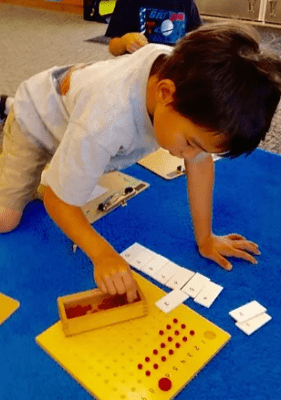Maria Montessori was truly a pioneer in child development and science; she believed that the mind and body are interconnected and this connection furthers the development of the whole person. How exactly does an authentic Montessori curriculum accomplish this?

Movement and Child Development
Movement is essential to child development, and not just in the obvious way of motor and physical development. While these are important developmental milestones on their own, research has shown that motor and cognitive development are fundamentally linked; brain imaging demonstrates that when we perform a cognitive task like a math worksheet, our motor AND cognitive centers light up. Proper motor development is thus vital to a child’s physical, social, psychological, and academic development. Motor skills can also influence language development, executive functioning (that voice inside your head that helps you stay out of trouble), and even academic performance.

Learning through Movement
Maria Montessori’s philosophy focuses on development of the whole person; Maria knew that mind and body were connected and aimed to connect them in her theories and practices on child development. At Heritage, our students are always moving! Preschool creates a foundation for learning, including movement. An authentic Montessori curriculum is not dictated by immobile learning with children tied to chairs and desks. While these furniture pieces are part of the classroom, they are not the WHOLE classroom. A typical Heritage school day requires that children are up from their chairs interacting with the material. The material is hands-on by design and requires manipulation not only for sensory learning, but for progression of motor and cognitive development as well. A Montessori student also engages in Practical Life activities and other activities like yoga to hone fine and gross motor skills. Research continues to support Montessori theory; studies have shown that educational activities that occur with physical movement positively influence academic achievement. For example, research has demonstrated that when children are allowed to stand and move during the school day, their memory, attention, mood, and academic achievement improve! More blood to the brain means more oxygen and nutrients to the brain, leading to more brain power!

Physical Activity and Health
Increased physical activity at school extends beyond the classroom and onto the playground. In Western societies, children spend up to 75% of the day inactive! At Heritage, we pride ourselves on our balanced curriculum that focuses on academic achievement and physical activity. Research has shown that physical activity is not just good for your heart, bones, and overall health, but it also leads to improved mood, self-esteem in children, and can help students maintain better attention and focus when inside the classroom!

*Tip for Working Parents: Decreasing your sitting time is better for adults’ health, too! Carve out some time in the evenings or on weekends to get active with your kids! Take nightly walks in the summer, throw a frisbee or football, walk the dog together or go to the park as a family. Even ten minutes can make a huge impact on the health of your family and being active together is a great way to strengthen your bond!
Final Thoughts
Physical activity isn’t only for the playground. A dynamic learning environment that engages the child’s senses and is hands-on helps break up the sitting routine and helps students’ minds grow!


